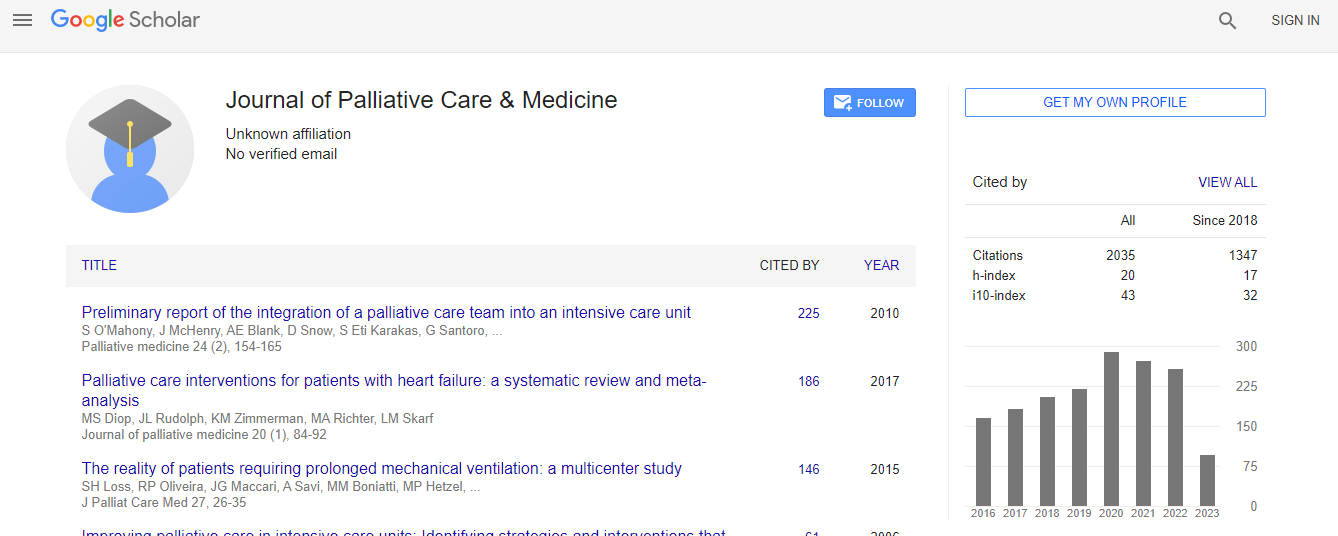Our Group organises 3000+ Global Conferenceseries Events every year across USA, Europe & Asia with support from 1000 more scientific Societies and Publishes 700+ Open Access Journals which contains over 50000 eminent personalities, reputed scientists as editorial board members.
Open Access Journals gaining more Readers and Citations
700 Journals and 15,000,000 Readers Each Journal is getting 25,000+ Readers
Recommended Conferences
42nd Global Conference on Nursing Care & Patient Safety
Toronto, CanadaGoogle Scholar citation report
Citations : 2035
Journal of Palliative Care & Medicine received 2035 citations as per Google Scholar report
Journal of Palliative Care & Medicine peer review process verified at publons
Indexed In
- Index Copernicus
- Google Scholar
- Open J Gate
- Genamics JournalSeek
- China National Knowledge Infrastructure (CNKI)
- Electronic Journals Library
- RefSeek
- Hamdard University
- EBSCO A-Z
- OCLC- WorldCat
- Virtual Library of Biology (vifabio)
- Publons
- Geneva Foundation for Medical Education and Research
- Euro Pub
- ICMJE
Useful Links
Recommended Journals
Related Subjects
Share This Page
What is the evidence for early integration of palliative care into the management of serious illness?
5th World Congress on Hospice and Palliative Care
Mellar P Davis
Geisinger Medical Center, USA
Posters & Accepted Abstracts: J Palliat Care Med
Abstract
Palliative care has emerged as an approach that specifically addresses gaps inherent in a disease-centered approach to care. Early palliative care has been promoted as the optimal approach to care for individuals with advanced illnesses. A systematic review of trials found 15 RCTs (Randomized Controlled Trials) of early outpatient, 13 RCTs of home palliative care and 7 systematic reviews. A subset of RCTs have demonstrated improved symptoms, quality of life, reduced aggressive care at the end of life, increased advanced directives, reduced hospital stays, improved caregiver burden and quality of life, reduced costs and improved family satisfaction. Yet RCT have also demonstrated no benefits to palliative care in the same outcomes. Why the difference? The term “early” and “standard of care” are poorly defined and subject to regional practices. Imbalances and attrition between groups contributed to differences in outcomes. Many RCTs lacked power calculations or were under powered for outcome measures. Outcomes were skewed yet parametric statistics were done giving weight to outliers in the results. Timing of assessment for outcomes in some trials was too early or late to see full benefits. Intention to treat analysis was often not done; outcomes were based on treatment analysis. Financial assessment was based exclusively on costs or charges centered on medical resource utilization rather than family expenditures. Multiple models of palliative care were used in these RCTs. This workshop/concurrent session will review the evidence for early palliative care and the differences and weaknesses in trials which may have contributed to divergent outcomes.Biography
E-mail: mdavis2@geisinger.edu

 Spanish
Spanish  Chinese
Chinese  Russian
Russian  German
German  French
French  Japanese
Japanese  Portuguese
Portuguese  Hindi
Hindi 
